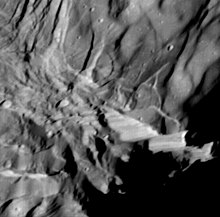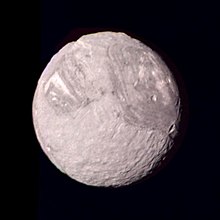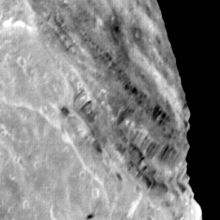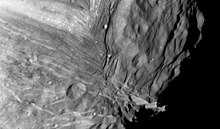Miranda (moon)
| Miranda | |
|---|---|

|
|
| Miranda captured by Voyager 2 on January 24, 1986 | |
| Central body | Uranus |
| Properties of the orbit | |
| Major semi-axis | 129,872 km |
| Periapsis | 129,703 km |
| Apoapsis | 130,041 km |
| eccentricity | 0.0013 |
| Orbit inclination | 4.338 ° |
| Orbital time | 1,413479 d |
| Mean orbital velocity | 6.68 km / s |
| Physical Properties | |
| Albedo | 0.32 ± 0.03 |
| Apparent brightness | 15.79 ± 0.04 mag |
| Medium diameter | 471.6 ± 1.4 (481 × 468.4 × 465.8) km |
| Dimensions | 6.59 ± 0.75 × 10 19 kg |
| surface | 700,000 km 2 |
| Medium density | 1.214 ± 0.109 g / cm 3 |
| Sidereal rotation | 1.4135 days |
| Axis inclination | 0 ° |
| Acceleration of gravity on the surface | 0.079 m / s 2 |
| Escape speed | 193 m / s |
| Surface temperature | −189 ± 1 ° C to −213 ° C (84 ± 1 - 60) K |
| discovery | |
| Explorer | |
| Date of discovery | February 16, 1948 |
| Remarks | Equator diameter is larger than pole diameter |

|
|
| Size comparison between Uranus (left) and its largest moons, from left to right Puck, Miranda, Ariel, Umbriel, Titania and Oberon (photo montage to scale) | |
Miranda (also Uranus V ) is the fourteenth innermost of the 27 known as well as the smallest and innermost of the five large moons of the planet Uranus . It is characterized by a particularly complex surface.
Discovery and naming
Miranda was discovered as the fifth Uranus moon on February 16, 1948 by the Dutch - American astronomer Gerard Peter Kuiper at the McDonald Observatory in Texas , 161 years after the discovery of Titania and Oberon .
All the moons of Uranus are named after characters by William Shakespeare or Alexander Pope , which goes back to a suggestion by the astronomer John Herschel , the son of the Uranus discoverer Wilhelm Herschel . Miranda is in Shakespeare's comedy The Tempest, the daughter of the magician Prospero, the rightful Duke of Milan. Miranda was the first of ten moons named after a figure from this play.
Track properties
Orbit
Miranda orbits Uranus on a prograde , almost perfectly circular orbit at an average distance of around 129,872 km (approx. 5.081 Uranus radii) from its center, i.e. around 104,300 km above its cloud ceiling. The orbital eccentricity is 0.0013, the web is 4,338 ° relative to the equator of Uranus inclined .
The orbit of the nearest inner moon Mab is on average 31,650 km away from Miranda's orbit, that of the next outer moon Ariel about 61,000 km.
Miranda is the first moon in the Uranus system to be entirely outside the rings. The outer edge of the outermost μ (My) dust ring is about 27,000 km from the Miranda orbit.
Miranda orbits Uranus in one day, 9 hours, 55 minutes and 25 seconds.
Since Miranda, like Uranus, practically orbits the sun on its side relative to the rotation, its northern and southern hemisphere points either directly towards the sun or away from it at the time of the solstice , which leads to extreme seasonal effects. This means that the poles of Miranda lie in permanent darkness or are illuminated by the sun for half a Uranus year of 42 years. During the solstice, the sun is therefore near the zenith over the poles. During the Voyager-2 flyby in 1986, which occurred almost at the solstice, the southern hemispheres of Uranus and its moons pointed toward the sun, while the northern hemispheres were in complete darkness. During the equinox , in which the equatorial plane crosses with the direction to earth and which also occurs every 42 years, mutual occultations of the Uranus moons and solar eclipses on Uranus are possible. A number of these events last took place between 2007 and 2008.
Currently, Miranda has no orbital resonance with other moons. However, in its history, she may have been in a 5: 3 resonance with Ariel as well as a 3: 1 resonance with Umbriel , which may have been responsible for the internal heating of Miranda.
rotation
The rotation time is the same as the orbital time and Miranda shows, like the earth's moon , a synchronous rotation , which also takes place within one day, 9 hours, 55 minutes and 25 seconds. Its axis of rotation is exactly perpendicular to its plane of the path .
Physical Properties
size
Miranda is somewhat irregular in shape with dimensions of 481 × 468.4 × 465.8 km. It is noteworthy that their equatorial diameter is larger than their pole diameter, which is extremely rare in the solar system for large to medium-sized moons. Their surface area has a high albedo of 0.32, i.e. That is, 32 percent of the light emitted by the sun is reflected. This corresponds roughly to the reflectivity of deserts on earth . The size of Miranda most closely resembles that of Saturn's moon Enceladus or that of Neptune's moon Proteus . Voyager 2 explored 45 to 50% of the surface, mostly - as with all Uranus moons - the southern hemisphere closer.
internal structure
Miranda is predominantly (about 80%) composed of water ice , with parts of silicate rock, and carbon compounds such as methane . Due to its composition, it has a low density of 1.214 g / cm 3 . The acceleration due to gravity on its surface is 0.079 m / s 2 , which is less than 1% of that on earth.
surface
Miranda was photographed and surveyed in January 1986 while the Voyager 2 spacecraft passed by . Its surface shows extreme faults , fragmentary patterns and a network of canyons that, including Verona Rupes, are up to 20 km deep. No other known celestial body has such structures, which is why Miranda is the geologically most interesting of the Uranus moons.
The maximum surface temperature of Miranda is −189 ° C (84 K ); on average, however, it is only an estimated −213 ° C (60 K).
The total area of Miranda is around 700,000 km 2 , which is roughly the size of France , Austria , Switzerland and Slovenia combined.
Coronae
The most conspicuous structures on Miranda's surface are the so-called coronae (Latin for wreaths), which differ greatly from the crater-strewn surroundings. There are few craters on them, which suggests a younger age. In general, the coronae are slightly darker than the surroundings, the albedo in lighter regions is 0.32 to 0.33, in darker regions between 0.25 and 0.26. The lighter highlands surrounding the Coronae have an average albedo value of 0.29.
Inverness Corona
This structure, which is known for its angular arrangement and is named after Inverness ( Scotland ), a town in Shakespeare's Macbeth , represents a depression in the surrounding highlands and measures 234 km in its maximum extent. The differences in brightness in this formation are exceptionally large, the albedo varies from 0.20 to at least 0.40. The formation of this complex area is based on a cryovolcanic origin.
The Inverness Corona is located near the geographic south pole of Miranda, which is immediately adjacent to the end of the longer part of the bright angle and the border with the highlands. To the north it is bounded by the Argier Rupes , a deep rift system with cliffs that extends from the Elsinore Corona to the Verona Rupes .
Elsinore Corona
This structure, reminiscent of a racecourse, which resembles structures on Jupiter's moon Ganymede , was named after Elsinore (English name for Helsingør , Denmark ) after Shakespeare's Hamlet . The parallel furrows, which extend around 30 ° south of the equator from west to east and are called Naples Sulcus , change direction at the east end by over 90 ° and continue to the north under the name Syracusa Sulcus . To the north and east, the Elsinore Corona is bounded by the rugged Ephesus Regio and the mountainous Sicilia Regio . The largest crater of the Elsinore Corona, which cuts the border with the highlands to the south, is called Stephano . The Elsinore Corona extends over 323 km, almost 70% of the entire moon diameter.
Arden Corona
Arden Corona, which is named after the Ardennes Forest ( Ardennes ) in Shakespeare's As You Like It , extends over 318 km and is similar in length to the Elsinore Corona , but is much wider. This structure seems to have been created by extensive upwelling . The only so far named crater of the Arden Corona stands out due to its great brightness and is called Gonzalo .
Regiones
The highlands surrounding the Coronae are divided into four previously named regions, the Mantua Regio , Dunsinane Regio , Sicilia Regio and Ephesus Regio . The first two are reminiscent of the highlands on the Earth's moon or the Saturn moon Mimas . The Mantua Regio is the most extensive structure on Miranda and covers an area of 399 km, while Dunsinane Regio has a diameter of 244 km.
The Sicilia Regio (extension 170 km) is characterized by particularly high mountains and has furrows that are similar to those on the Martian moon Phobos . The Ephesus Regio (extension 225 km), which was only named in 1997 and connects to the Elsinore Corona to the north , represents a separate, particularly irregularly furrowed and pitted region. Only a small part of this region is visible on the previous images.
Like all surface structures on Miranda, the regions were named after Shakespeare plays, namely Mantua ( Italy ) from Romeo and Juliet and Two Gentlemen from Verona , Dunsinane Hill from Macbeth , Sicilia from Winter's Tale and Ephesus ( Turkey ) from The Comedy of Errors .
Rupes
Verona rupes

Miranda has two extensive rift systems, which stand out due to their steep, high-walled cliffs (Latin: Rupes) and are unique in the solar system. Verona Rupes in particular , named after the location of the action in Shakespeare's Romeo and Juliet , is particularly well known because the height of this cliff is an estimated 20 km and because of its fortuitous proximity to the day / night boundary at the time of the Voyager 2 flyby , in which the surface structures of a body are particularly clearly visible through the formation of shadows, was photographed in a media-effective way. Verona Rupes separates the Sicilia Regio from the Dunsinane Regio and extends in a north-south direction.
Argier Rupes
This rift system, named after Algiers in Shakespeare's The Storm , runs from the Elsinore Corona in a west-east direction and separates the Inverness Corona in the south from the Sicilia Regio in the north. The slopes on the north side of Argier Rupes are significantly higher and flatter towards the east; at its foothills, near the largest named crater Alonso , joins the Verona Rupes . Towards Inverness Corona , the slopes are not that high, but much steeper.
crater
Of the countless impact craters on Miranda are so far only seven of the International Astronomical Union officially named (IAU), according to the USGS - Nomenclature all after characters from Shakespeare's The Tempest . The named craters are all in the crater-strewn highlands, with the exception of the Stephano crater , which is on the edge of the Elsinore Corona . The largest named crater is Alonso at 25 km . Five of the seven crater names were also used for the nine irregular outer moons of Uranus discovered between 1997 and 2003, namely Francisco , Ferdinand , Prospero , Stephano and Trinculo .
| Surname | Diameter (km) | Coordinates | Origin of name |
|---|---|---|---|
| Alonso | 25.0 | 44 ° 00 ′ S 352 ° 36 ′ E / 44.0 ° S 352.6 ° E | Alonso , King of Naples in The Storm |
| Prospero | 21.0 | 32 ° 54 ′ S 329 ° 54 ′ E / 32.9 ° S 329.9 ° E | Prospero , the magician and main character in The Tempest |
| Ferdinand | 17.0 | 34 ° 48 ′ S 202 ° 06 ′ E / 34.8 ° S 202.1 ° E | Ferdinand , King Alonso's son in The Storm |
| Stephano | 16.0 | 41 ° 06 ′ S 234 ° 06 ′ E / 41.1 ° S 234.1 ° E | Stephano , the drunk butler in The Tempest |
| Francisco | 14.0 | 73 ° 12 ′ S 236 ° 00 ′ E / 73.2 ° S 236.0 ° E | Francisco , a Lord of Naples in The Tempest |
| Trinculo | 11.0 | 63 ° 42 ′ S 163 ° 24 ′ E / 63.7 ° S 163.4 ° E | Trinculo , the jester in The Storm |
| Gonzalo | 11.0 | 11 ° 24 ′ S 77 ° 00 ′ E / 11.4 ° S 77.0 ° E | Gonzalo , a Lord of Naples in The Tempest |
Theories of origin
The collision theory
The ubiquity of impact craters and the mosaic-like structures of the surface meant that this theory was established soon after Voyager 2's flyby. Accordingly, the moon was apparently torn apart once or several times in its history and reassembled due to its own gravity . The cause was assumed to be that either strong tidal forces from Uranus tore the moon apart, or it was shattered by a collision with another celestial body, the latter theory seemed more likely. This theory is now considered obsolete, as no evidence of such events can be found.
The orbital resonance theory
Theoretical models of the orbital evolution of the Uranus system provide evidence that Miranda was in a 5: 3 orbit resonance with the moon Ariel and a 3: 1 resonance with Umbriel in its early days . This theory, which is now generally accepted as valid, is supported by the fact that the orbital inclination observed today is about ten times higher than that of the other regular Uranus moons. Thereafter, Miranda always came after three orbits into the gravitational sphere of influence of Umbriel or after five orbits in that of Ariel. In both cases, this provided Miranda with additional rail power. As a result, Miranda's orbit became increasingly eccentric and, in its periapsis, came under greater influence from Uranus' tidal forces. The result was that parts of Miranda's interior heated up, diapirs of warmer water ice rose and tectonic processes set in motion that shaped the structures that are visible today, such as the coronae and the fold mountains . After a certain time, however, Miranda escaped the resonance with Umbriel, which was favored by the lower flattening of Uranus and the - relatively speaking - larger moons compared to Jupiter and Saturn . As a result, the moon cooled down again.
exploration
For several decades after the discovery by Gerard Kuiper in 1948, little was known about Miranda other than the orbit parameters. The moon was too small and too far away to be resolved with terrestrial telescopes. The big breakthrough came in January 1986 at the flyby of the Voyager 2 - space probe to Uranus. As a result of the high inclination of the axis of 98 °, the axis of rotation of the planet pointed towards Earth at this point in time, so that the moons of Uranus could not be approached individually on the equatorial plane as was previously the case with Jupiter and Saturn, but their orbits like a target around the planet and the planet had to be hit. This meant that every two days, only the southern hemisphere of all moons of Uranus could be photographed - the worst possible position for a flyby. In addition, you had to choose a moon, as a close pass by inevitably required large distances to all others.
Since Voyager 2 was to be steered further to Neptune , the prerequisite for this was a close Uranus flyby. From this it emerged that only Miranda could be passed close, which was initially not the preferred target for the participating scientists due to its size and the supposed assumption of a geologically dead world like the Saturn moon Mimas . So it was a stroke of luck that the most interesting surface of the Uranus system could be captured up close. Voyager 2 passed Miranda on January 24, 1986 at a distance of 29,000 km and sent a series of high-resolution images back to Earth.
Web links
- Polish moon page: Miranda description and further links (Polish) (web.archive.org)
- Satellite Viewer Orbit simulation of the Uranus moons
- Dr. Schenk's 3D House of Satellites: Miranda's Warning Perspective Models by Miranda (English)
- USGS list of named structures on Miranda
- Gerard Kuiper: The fifth satellite of Uranus discovery report and naming 1949 (English)
Individual evidence
- ↑ bibcode : 1949PASP ... 61..129K , p. 129
- ^ J. Hillier, P. Helfenstein, J. Veverka: Miranda: Color and Albedo variations from Voyager photometry. In: Icarus. 82, 1989, p. 314, doi : 10.1016 / 0019-1035 (89) 90041-9 .
- ↑ Croft, SK: Miranda's Inverness Corona Interpreted as a Cryovolcanic Complex . 1988, bibcode : 1988LPI .... 19..225C .






